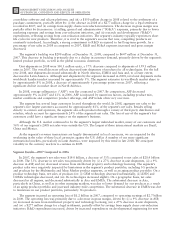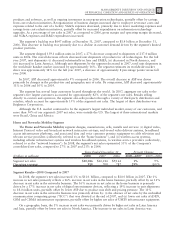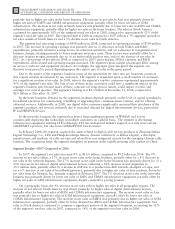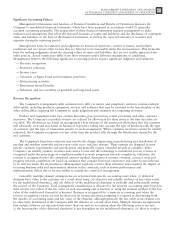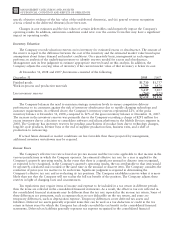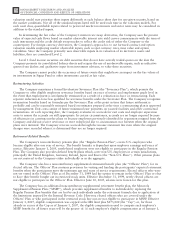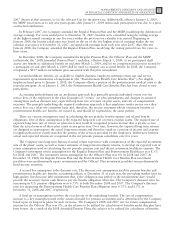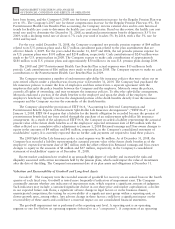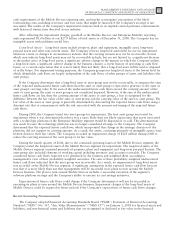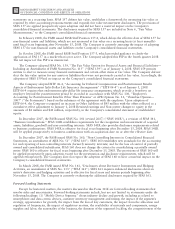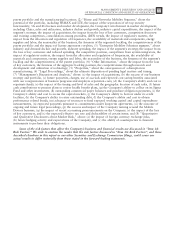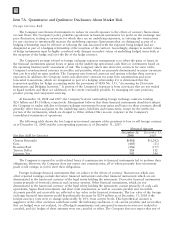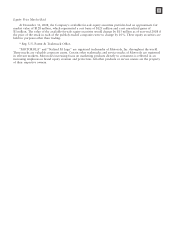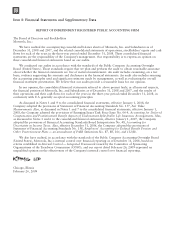Motorola 2008 Annual Report Download - page 80
Download and view the complete annual report
Please find page 80 of the 2008 Motorola annual report below. You can navigate through the pages in the report by either clicking on the pages listed below, or by using the keyword search tool below to find specific information within the annual report.
have been frozen, and the Company’s 2008 rate for future compensation increase for the Regular Pension Plan was
set to 0%. The Company’s 2007 rate for future compensation increase for the Regular Pension Plan was 4%. For
Postretirement Health Care Benefits Plan accounting, the Company reviews external data and its own historical
trends for health care costs to determine the health care cost trend rates. Based on this review, the health care cost
trend rate used to determine the December 31, 2008 accumulated postretirement benefit obligation is 8.5% for
2009, with a declining trend rate of about 0.7% each year until it reaches 5% by 2014, with a flat 5% rate for
2014 and beyond.
For the year ended December 31, 2008, the Company recognized net periodic pension expense of $64 million
related to its U.S. pension plans and a $237 million curtailment gain related to the plan amendments that are
effective March 1, 2009. For the years ended December 31, 2007 and 2006, the net periodic pension expense for
its U.S. pension plans were $191 million and $258 million, respectively. Cash contributions of $243 million were
made to the U.S. pension plans in 2008. The Company expects to make cash contributions of approximately
$180 million to its U.S. pension plans and approximately $50 million to its non-U.S. pension plans during 2009.
The 2008 and 2007 Postretirement Health Care Benefits Plan actual expenses were $15 million in both
periods. Cash contributions of $16 million were made to this plan in 2008. The Company expects to make no cash
contributions to the Postretirement Health Care Benefits Plan in 2009.
The Company maintains a number of endorsement split-dollar life insurance policies that were taken out on
now-retired officers under a plan that was frozen prior to December 31, 2004. The Company had purchased the
life insurance policies to insure the lives of employees and then entered into a separate agreement with the
employees that split the policy benefits between the Company and the employee. Motorola owns the policies,
controls all rights of ownership, and may terminate the insurance policies. To effect the split-dollar arrangement,
Motorola endorsed a portion of the death benefits to the employee and upon the death of the employee, the
employee’s beneficiary typically receives the designated portion of the death benefits directly from the insurance
company and the Company receives the remainder of the death benefits.
The Company adopted the provisions of EITF 06-4, “Accounting for Deferred Compensation and
Postretirement Benefit Aspects of Endorsement Split-Dollar Life Insurance Arrangements” (“EITF 06-4”) as of
January 1, 2008. EITF 06-4 requires that a liability for the benefit obligation be recorded because the promise of
postretirement benefit had not been settled through the purchase of an endorsement split-dollar life insurance
arrangement. As a result of the adoption of EITF 06-4, the Company recorded a liability representing the actuarial
present value of the future death benefits as of the employees’ expected retirement date of $45 million with the
offset reflected as a cumulative-effect adjustment to January 1, 2008 Retained earnings and Non-owner changes to
equity in the amounts of $4 million and $41 million, respectively, in the Company’s consolidated statement of
stockholders’ equity. It is currently expected that no further cash payments are required to fund these policies.
The 2008 Split-Dollar Life Insurance policy actual expense was $6 million. As of December 31, 2008, the
Company has recorded a liability representing the actuarial present value of the future death benefits as of the
employees’ expected retirement date of $47 million with the offset reflected in Retained earnings and Non-owner
changes to equity in the amounts of $4 million and $37 million, respectively, in the Company’s consolidated
statement of stockholders’ equity as of December 31, 2008.
Recent market conditions have resulted in an unusually high degree of volatility and increased the risks and
illiquidity associated with certain investments held by the pension plans, which could impact the value of investments
after the date of this filing. The Company’s measurement date of its plan assets and obligations is December 31.
Valuation and Recoverability of Goodwill and Long-lived Assets
Goodwill: The Company tests the recorded amount of goodwill for recovery on an annual basis in the fourth
quarter of each fiscal year. Goodwill is tested more frequently if indicators of impairment exist. The Company
continually assesses whether any indicators of impairment exist, which requires a significant amount of judgment.
Such indicators may include: a sustained significant decline in our share price and market capitalization; a decline
in our expected future cash flows; a significant adverse change in legal factors or in the business climate;
unanticipated competition; the testing for recoverability of a significant asset group within a reporting unit; or
slower growth rates, among others. Any adverse change in these factors could have a significant impact on the
recoverability of these assets and could have a material impact on our consolidated financial statements.
The goodwill impairment test is performed at the reporting unit level. A reporting unit is an operating
segment or one level below an operating segment (referred to as a “component”). A component of an operating
72 MANAGEMENT’S DISCUSSION AND ANALYSIS
OF FINANCIAL CONDITION AND RESULTS OF OPERATIONS


